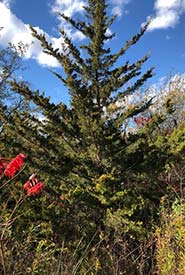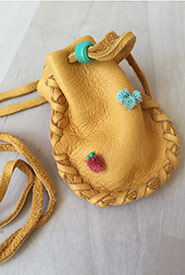The resiliency and significance of cedar

Eastern red cedar (Photo by Onel Guce, CC BY-NC 4.0)
It seems like everywhere I go, I see cedar trees.
This isn’t surprising, since Canada’s four species of cedar can be common where they occur. Growing up to 15 metres tall and representing some of the oldest trees in Canada, cedar holds special meaning to me. I take seeing this tree as a sign from Creator that I’m on the right path. Whether that means renting the apartment in a building lined with cedar trees, naming our new puppy after this sacred medicine, or even seeing a cedar tree when I have something weighing on my mind, cedar has been a steady presence that has helped me cope with life’s ever-changing challenges — some of which have all been tested this year.

Cedar the pup with cedar the tree (Photo by Raechel Bonomo/NCC)
Cedar is one of the four medicine plants in many, but not all, Indigenous cultures across North America. First there is tobacco, which was given to my Peoples at the start of Creation. The other two plants, sweet grass and sage, along with cedar, follow tobacco. It is said that tobacco is the spirit of all other plant life on Earth. Each has its own healing properties and spiritual significance. For me personally, cedar is the medicine I reach for most often when I need clarity and to de-stress.
Cedar is used for many purposes in some Indigenous cultures, specifically in First Nations and Métis communities. As with all four medicine plants, it can be used for smudging. It is also used for purification, healing and protection. In some cases, cedar branches may be used during fasting, sweat lodge and other ceremonies to cover the floor of or in a circle around the sacred area.
Cedar has been used for millennia by Indigenous Peoples as a source of nutrition, too. Cedar contains vitamin C and can be steeped like a tea to ease cold-like symptoms, such as sore throats, coughing and congestion.
Cedar trees were also used by our ancestors for other purposes. For example, in British Columbia, the fibrous inner bark of cedar trees in this region were used to make clothing, blankets, diapers and rope. Their outer bark was used for infrastructure, such as for roofing and to cover canoes.
The more I learn about this sacred medicine, the more I’m connected to it. I recognize the significance it has had and continues to hold in some Indigenous communities in Canada. I respect this species as one that allows me to connect to my ancestors and my culture.

A tufted medicine pouch that I recently made (Photo by Raechel Bonomo/NCC)
The resiliency of this tree on landscapes across Canada mirrors the history of Indigenous Peoples here. To this day, like the mighty cedar tree, my Haudenosaunee community and other Indigenous Peoples across Canada stand strong and proud.
And now, cedar literally follows me everywhere I go. This time, it’s in the form of a four-legged, teething monster covered in black and white fur. Standing a mere one foot off the ground, Cedar, our border collie miniature pinscher mix, has brought the same healing to our home as the cedar bundles I keep in my medicine pouch.
It’s through this healing strength, one I am always reminded of when I see cedar (in all forms), that I find my peace.


